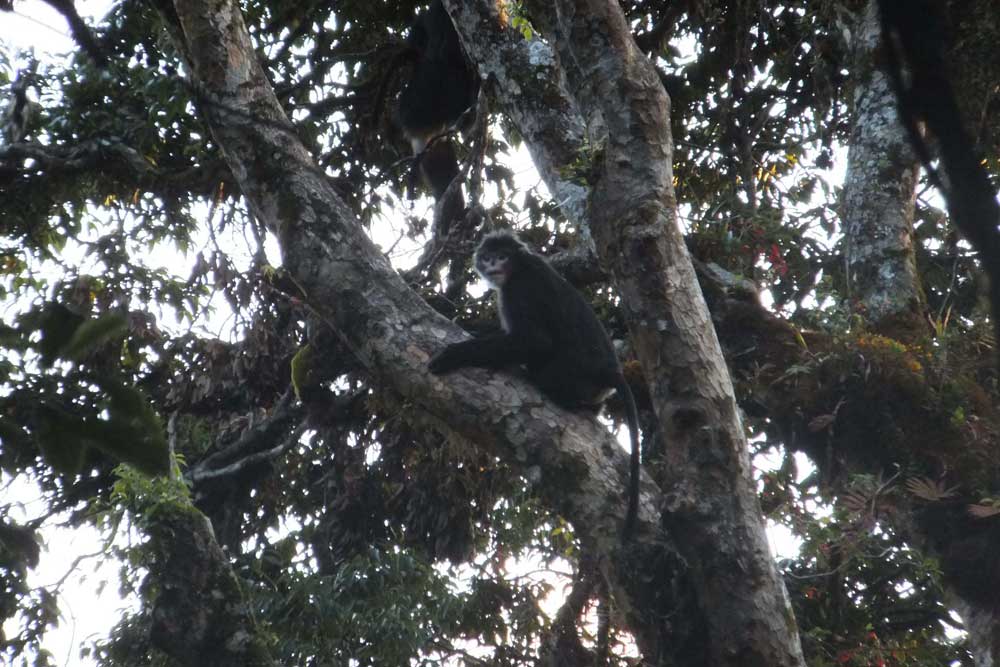
Elusive Sneezing Monkeys Photographed in a First

A group of monkeys whose nostrils are so upturned they are said to sneeze audibly when it rains has been discovered in China, say researchers, who have now snapped the first photographic evidence of the snub-nosed monkeys there.
The monkey species, Rhinopithecus strykeri, was first reported to exist in October 2010. With no photographic evidence of a live specimen that year, the researchers made a Photoshop reconstruction of it based on a Yunnan snub-nosed monkey and a carcass of the newly discovered species.
At the time, scientists thought the species was limited to the Kachin state of northeastern Myanmar.
The new discovery of the monkey, called "mey nwoah" in local dialects (or "monkey with an upturned face"), suggests its range extends into China. [See Photos of Snub-Nosed Monkeys]
"Our finding of a population of black snub-nosed monkeys was widely celebrated in China," the researchers write in the American Journal of Primatology.
Monkey sneezes
The snub-nosed monkeys are about 21 inches (55 centimeters) long from nose to rump, with tails extending some 30 inches (78 cm). Their fur is black with white ear tufts and white moustaches sitting on their bare-pink faces.
Sign up for the Live Science daily newsletter now
Get the world’s most fascinating discoveries delivered straight to your inbox.
According to local hunters, the monkeys, Rhinopithecus Strykeri, sit with their heads tucked between their knees on drizzly days to keep from inhaling water. When the water gets caught in their noses, they sneeze, locals say.
Researchers were alerted to this hidden group of monkeys after Liu Pu, a forest guard for Gaoligongshan National Nature Reser, snapped photos of them in a forest near Pianma, in Yunann's Lushui County. To check it out, Yongcheng Long from the Nature Conservancy China Program led a team there.
Pinning down monkey numbers
The scientists photographed and filmed the monkeys in March 2012, estimating fewer than 100 snub-nosed monkeys there.
"However, while we now know the home range to be far greater than previously believed, we still do not yet know the true population number or the extent of their home range as the monkeys are shy and very hard to access," Long said in a statement.
Even so, the species is still considered critically endangered, the scientists warned.
"This monkey group was actually found in an area designated as a nature reserve 30 years ago, and while local people have been hunting the species for ages, local managers knew nothing about it," Long said. "This highlights the need to improve wildlife management in China, as it is likely quite a few new species of plants and animals may be discovered in the border areas between China and Myanmar."
Follow LiveScience on Twitter @livescience. We're also on Facebook & Google+.
Jeanna Bryner is managing editor of Scientific American. Previously she was editor in chief of Live Science and, prior to that, an editor at Scholastic's Science World magazine. Bryner has an English degree from Salisbury University, a master's degree in biogeochemistry and environmental sciences from the University of Maryland and a graduate science journalism degree from New York University. She has worked as a biologist in Florida, where she monitored wetlands and did field surveys for endangered species, including the gorgeous Florida Scrub Jay. She also received an ocean sciences journalism fellowship from the Woods Hole Oceanographic Institution. She is a firm believer that science is for everyone and that just about everything can be viewed through the lens of science.









